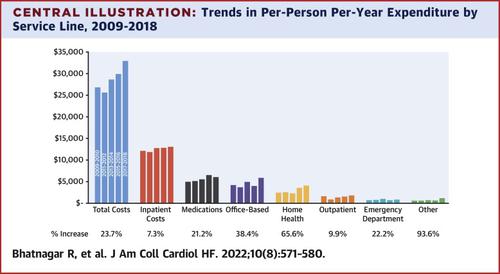JACC: Heart Failure ( IF 10.3 ) Pub Date : 2022-07-06 , DOI: 10.1016/j.jchf.2022.05.006 Roshni Bhatnagar 1 , Gregg C Fonarow 2 , Paul A Heidenreich 3 , Boback Ziaeian 4

|
Background
With rising United States health care expenditure, estimating current spending for patients with heart failure (HF) informs the value of preventative health interventions.
Objectives
The purpose of this study was to estimate current health care expenditure growth for patients with HF in the United States.
Methods
The authors pooled MEPS (Medical Expenditure Panel Survey) data from 2009-2018 to calculate total HF-related expenditure across clinical settings in the United States. A 2-part model adjusted for demographics, comorbidities, and year was used to estimate annual mean and incremental expenditures associated with HF.
Results
In the United States, an average of $28,950 (2018 inflation-adjusted dollars) is spent per year for health care–related expenditure for individuals with HF compared with $5,727 for individuals without HF. After adjusting for demographics and comorbidities, a diagnosis of HF was associated with $3,594 in annual incremental expenditure compared with those without HF. HF-related expenditure increased from $26,864 annual per person in 2009-2010 to $32,955 in 2017-2018, representing a 23% rise over 10 years. In comparison, expenditure on myocardial infarction, type 2 diabetes mellitus, and cancer grew by 16%, 28%, and 16%, respectively. Most of the cost was related to hospitalization: $12,569 per year. Outpatient office-based care and prescription medications saw the greatest growth in cost over the period, 41% and 24%, respectively. Estimated incremental national expenditure for HF per year was $22.3 billion; total annual expenditure for adults with HF was $179.5 billion.
Conclusions
HF is a costly condition for which expenditure is growing faster than that of other chronic conditions.
中文翻译:

美国心力衰竭的支出
背景
随着美国医疗保健支出的不断增加,估算心力衰竭 (HF) 患者当前的支出可以了解预防性健康干预措施的价值。
目标
本研究的目的是估计美国心力衰竭患者目前的医疗保健支出增长情况。
方法
作者汇总了 2009 年至 2018 年的 MEPS(医疗支出小组调查)数据,以计算美国临床环境中与心力衰竭相关的总支出。根据人口统计、合并症和年份调整的两部分模型用于估计与心力衰竭相关的年度平均和增量支出。
结果
在美国,心力衰竭患者每年平均花费 28,950 美元(2018 年通货膨胀调整后的美元)用于医疗保健相关支出,而无心力衰竭患者则为 5,727 美元。调整人口统计数据和合并症后,与无心力衰竭的患者相比,心力衰竭的诊断每年增加 3,594 美元的支出。与高频相关的支出从 2009-2010 年的每人每年 26,864 美元增加到 2017-2018 年的每人 32,955 美元,10 年来增长了 23%。相比之下,心肌梗塞、2 型糖尿病和癌症的支出分别增长了 16%、28% 和 16%。大部分费用与住院有关:每年 12,569 美元。在此期间,门诊护理和处方药的成本增幅最大,分别为 41% 和 24%。国家每年在高频方面的增量支出估计为 223 亿美元;成人心力衰竭的年度总支出为 1795 亿美元。
结论
心力衰竭是一种成本高昂的疾病,其支出增长速度快于其他慢性病。











































 京公网安备 11010802027423号
京公网安备 11010802027423号